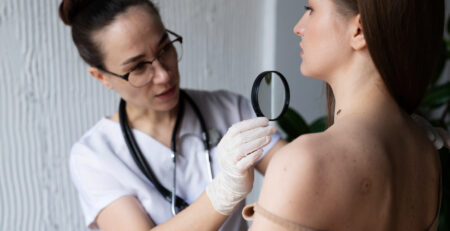Psoriasis: Causes, Symptoms, and Treatments
Psoriasis is a common skin disease that affects more than 8 million people in the United States alone, according to the National Psoriasis Foundation. Up to 40% of people with psoriasis get it before they are 16 years old, and about 10% get it before they are 10 years old. Psoriasis makes skin cells grow too fast, which can cause a lot of problems. Read on to find out more about what causes psoriasis, what its symptoms are, and how to treat it.
First Thing’s First, What Is Psoriasis?
Psoriasis can lead to skin problems like an itchy rash with red or white, thick, scaly patches. Psoriasis is a long-term, auto-immune disease with signs that can get worse or better over time. For example, a person with psoriasis may have a painful flare-up that lasts for a few weeks, then goes away for a while, only to come back later.
When a person has psoriasis, skin cells build up quickly and make patches or scales on their skin. The affected areas on the surface of the skin are also more likely to get red and swollen. Depending on how bad the condition is, psoriasis can affect just a few spots on the body or more of it. It usually shows up on the elbows and knees, but the scales can also show up on the hands, feet, neck, scalp, face, nails, and mouth.
Psoriasis starts out as small red bumps that get bigger as scales form on top. More growth can cause sores, plaques, or scales on the skin that are likely to bleed when scratched.
What Causes or Triggers Psoriasis?
Experts think that psoriasis can be caused by genes or a weak immune system. If someone in your family has psoriasis, you may also get it. However, the disease has been known to skip generations.
Also, if your immune system isn’t working well, skin cells can be replaced faster than they fall off. Psoriasis is called an autoimmune disease because it’s thought that the body’s white blood cells attack healthy skin cells. Still, scientists are still looking into psoriasis to find out what causes it.
People who already have psoriasis can have an outbreak because of a number of outside factors. Stress, bacterial infections, skin injuries like cuts, scrapes, or incisions from surgery, the weather, smoking, drinking alcohol, immune disorders like HIV, and some medications can all cause hives.
Psoriasis Risk Factors and Complications
Psoriasis can happen to anyone at any age, to both men and women. Still, you are more likely to have psoriasis if it runs in your family, if you smoke, or if you drink alcohol.
Having psoriasis also puts you at risk for other problems, like psoriatic arthritis, type 2 diabetes, heart disease, eye problems like conjunctivitis, and problems with your mental health. Psoriasis has been linked to anxiety, depression, and low self-esteem, among other mental health problems.
Common Signs and Symptoms of Psoriasis
There are different kinds of psoriasis, each with its own signs and symptoms. Most of the time, the following are active signs of psoriasis:
- A rash on different parts of the body that can look like dandruff scales or sores.
- Cracked and dry skin that’s prone to bleeding
- Skin patches that itch, burn, or are sore
- Nail disorders, such as discoloration or pitting
People with psoriasis don’t always have the same symptoms. There are different kinds of psoriasis, and the scaly patches it causes can be red, brown, purple, or white-silver, depending on the colour of the person’s skin.
What Are the Types of Psoriasis?
As was already said, there are different kinds of psoriasis, and each has its own signs and symptoms.
One of the most common types of psoriasis is called plaque psoriasis. It is marked by skin plaques, which are raised patches of skin that are dry, itchy, scaly, and red. Plaques of skin often show up on the scalp, elbows, knees, and lower back. They can be different colours and have different amounts of scaling.
Inverse Psoriasis: Unlike skin plaques, inverse psoriasis usually shows up in skin folds around the armpits, groyne, and breasts. It’s more likely to happen when you sweat or rub your skin, and it makes your skin red, smooth, and shiny in patches.
Nail psoriasis affects the fingernails and toenails, as the name suggests. Some of the most common signs of this type of nail problem are pitted, loose, and crumbling nails, discoloration, and nails that grow in a strange way.
Pustular Psoriasis: One of the most common types of psoriasis in adults is pustular psoriasis. Small pustules form on red, scaly skin, and the condition usually affects the hands and soles of the feet. Pus can get inside the bumps or blisters.
Erythrodermic Psoriasis: This is one of the less common types of psoriasis. It is a severe form of psoriasis that can put a person’s life at risk, causes fever, and needs treatment right away. It can cover your whole body or large parts of it with bright red scales that fall off in sheets.
Guttate psoriasis is one of the most common types of psoriasis in children and young adults. Small patches of red, scaly skin show up mostly on the arms, trunk, and legs. Guttate psoriasis is often brought on by tonsillitis, lung infections, skin injuries, or strep throat.
When Should You See a Doctor for Psoriasis Treatment?
If you think you might have the condition, you should see a doctor. This is especially true if the condition gets worse and starts to hurt, make you feel bad about yourself, or make you feel uncomfortable.
When you go to a qualified doctor or nurse, they will first do a full physical exam to make a formal diagnosis. Your doctor will look at different parts of your body, like your scalp, elbows, knees, toenails, and feet. They will ask you about psoriasis in your family, and if they think you might have it, they might do a biopsy. Lab tests and physical exams can both be used to figure out what’s wrong.
Psoriasis Treatments
If you have been diagnosed with psoriasis, your doctor will talk with you about different ways to treat it based on your age, overall health, the severity and frequency of the rash, and how long it has been going on. Remember that psoriasis can’t be cured, so treatments will try to ease the signs and symptoms you’re feeling. Treatments for psoriasis that work well can help control inflammation and the turnover of skin cells. In general, you have three main choices for how to treat psoriasis.
- Topical treatments: You can use creams and other treatments to make your skin better. Most of the time, topical treatments are given for mild cases.
- Medicines: If you have moderate to severe psoriasis, medicines are often the best choice. But if the medicine makes you feel bad, this might not be a good long-term solution.
- Therapy: Light therapy with UV rays or immune therapy can also be used to treat psoriasis.
Adding lifestyle changes like better stress management, healthy weight loss, and a balanced diet to these treatments can also make a big difference.
What Else Do You Need to Know About Psoriasis?
People can get both psoriasis and eczema, but they are not the same thing. Psoriasis is not contagious, so you can’t get it from being around someone who already has it. Psoriatic arthritis is more likely to be diagnosed if you have psoriasis. Joints that are swollen, painful, and inflamed are all signs and symptoms of psoriatic arthritis.
Schedule A Consultation with A BRITHIKA Affiliated Provider
Even though there is no cure for psoriasis, treatment can make your life much better. With the BRITHIKA, you can find skilled and highly qualified doctors who can help you deal with even the worst flare-ups. As was already said, getting rid of psoriasis can make you happier and healthier.
Start your journey to effective treatment by getting help from a provider who is part of the Brithika network. The BRITHIKA is made up of doctors and dermatologists who you can trust and who can always give you a high level of care.












Leave a Reply